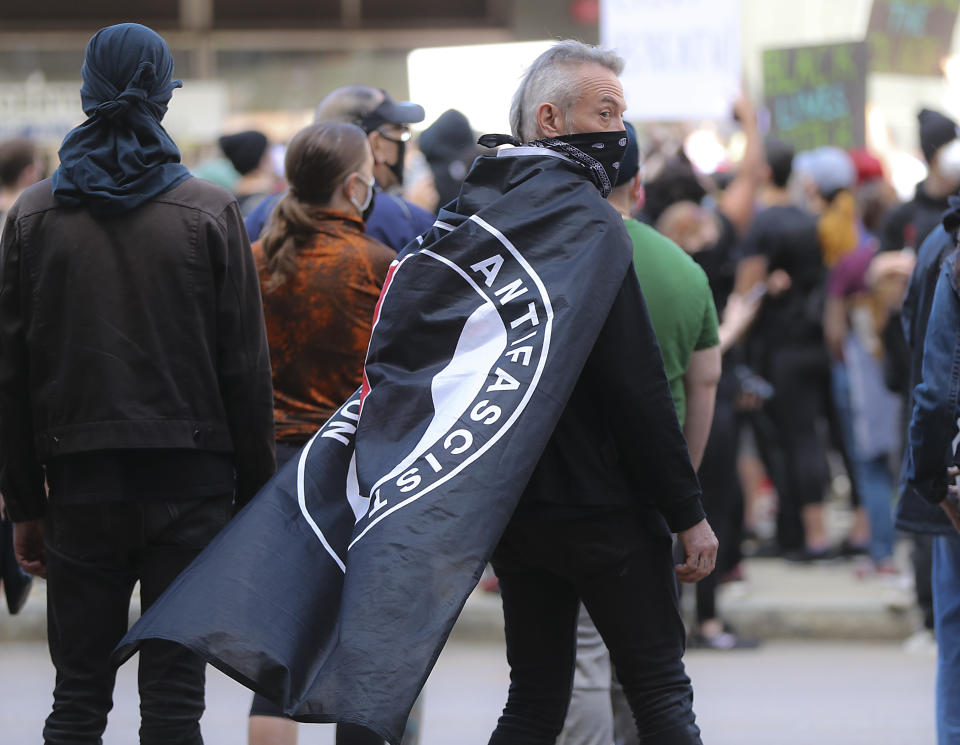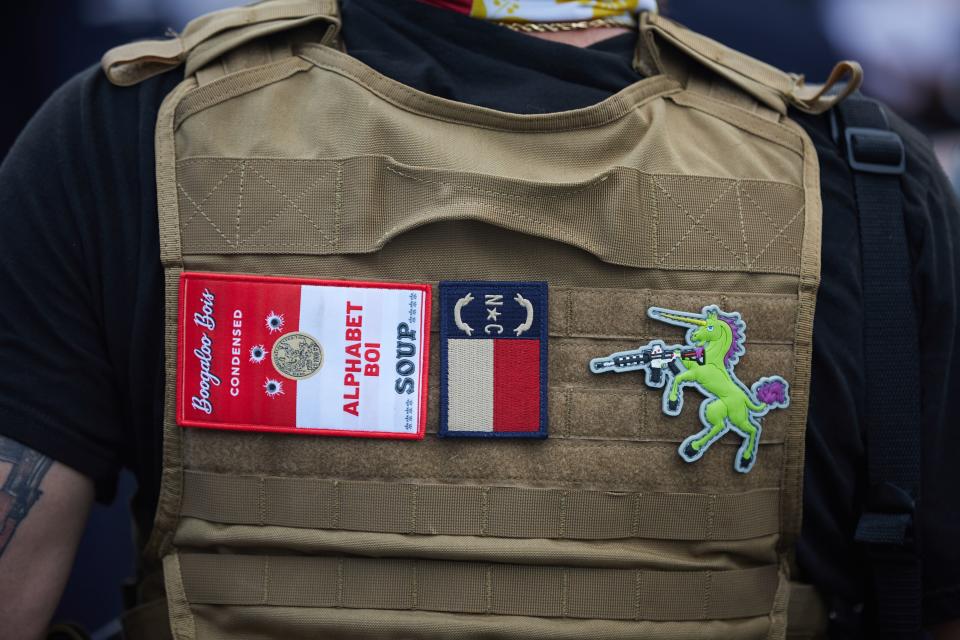Violent protests shine spotlight on extremists, from antifa to 'Boogaloo'
The majority of protests over the past week calling for systemic reforms to end police violence after the deaths of George Floyd in Minneapolis and Breonna Taylor in Louisville have been peaceful. But some have turned violent, with looting in some cities and possible instances of police brutality in others.
President Trump has blamed antifa, an umbrella term for radical left-wing activist groups that sometimes engage in street brawls, for the violence. However, antifa’s ties to the past week’s protests are unclear.
While elected officials across the country have pointed fingers at outside agitators for the violence, so far there is limited evidence that outside extremist groups have been involved. For example, Minnesota officials initially said that all the Friday night arrests in the Twin Cities were from out of state, a claim they later walked back.
“Public protests like this are going to attract people of all kinds,” Oren Segal, vice president of the Anti-Defamation League’s Center on Extremism, told Yahoo News.
“No extremist is going to miss an opportunity to try to leverage a crisis to amplify their views and push their agenda,” said Segal. But we have no evidence — none — that any extremist movement, or group that embraces extremist tactics, is significantly organizing any of these events.”

While protesters call for reform measures the White House has resisted — including Justice Department oversight of police departments with a history of violence, an agreement known as “consent decrees,” and ending the transfer of military equipment to local police — Trump has used his bully pulpit to push for harsher crackdowns, specifically in regard to antifa.
“A national Oval Office address is not going to stop antifa,” White House press secretary Kayleigh McEnany said Monday morning. “What’s going to stop antifa is action. And this president has committed to acting on this. He has several meetings pertaining to that today. And that’s his focus — acting and keeping our streets safe.”
On Sunday, Trump announced that he was declaring antifa a terrorist organization, even though it’s not an organization in the formal sense and he does not have the ability to designate domestic terrorist groups.
Short for anti-facist, antifa refers to a secretive movement of combative leftists, including many self-described anarchists, who are ready and willing to use violence in order to fight white supremacists, neo-Nazis and others they deem to be “fascists.” They attempt to “deplatform” anyone they consider homophobic, racist or xenophobic, a process that sometimes involves shutting down controversial speakers or gatherings through the use of force.
Antifa traces its origins to the street fights between European right-wing and left-wing groups in the 1920s and ’30s. The American version of the movement is rather new; Rose City Antifa, a group in Portland, Ore., that is one of the most well-known chapters, says it was founded in 2007.
But, Segal explained, antifa is not an organized group in the traditional sense.
“It’s not like antifa has card-carrying members,” he said, suggesting that “in some ways it’s more of a concept or movement than group structure.” Due to the loose, decentralized style of organizing, it’s impossible to tell how many people are involved in antifa.
Segal noted similarities between the fluidity of antifa and other modern extremist movements, such as the far-right “Boogaloo,” which is also not really a group but rather a “concept that means so many different things to different people.”
“This is the challenge [with] designations of any kind against any sort of ideologically motivated movement,” he said, referring to Trump’s recent pledge to designate antifa as a terrorist organization. “Less and less, organizational structure is not the glue that keeps movements together. It’s the ideology.”
As a result, Segal said, antifa activity is “much more difficult to track, which, by the way, is by design.”

There are, of course, certain social media channels run by people who self-identify as antifa, but on the internet as well as in the real world, it’s almost impossible to gauge who, exactly, is involved in this loosely defined movement and to what degree. Basically, Segal said, “you are if you say you are.”
“It’s quite hard to know the level of on-the-ground engagement because not everybody is going to identify their worldview and their affiliations while they’re at a protest,” he said.
“I think sometimes people assume that black-clad people are antifa, and that’s not necessarily the case. We have anarchists, and we have people who are just angry, period. I will say anarchists are opportunistic and they view unrest in society as an opportunity to destroy the corrupt system, in some cases.”
Segal noted that “property destruction” is “a classic anarchist tactic,” and New York City officials have blamed anarchists for the violence there. Antifa generally focuses on those they deem as racist or fascist, taking them on through direct physical confrontation or releasing their personal information in an attempt to cost them their jobs or otherwise shame them.
Trump has used antifa interchangeably with anarchists. While some members of antifa would describe themselves as anarchists, the anarchist movement as a whole rejects governments of any kind and has been responsible for protests and violence for decades. Antifa and anarchist groups do, however, share a similar dress code of black clothing and masks.
Videos circulating on social media suggest that young, white men — the demographic both antifa and “Boogaloo” tend to draw from — are responsible for much of the violence over the last week, although their exact affiliations and ideologies are unknown. This confusion allows for the possibility that both far-left and far-right groups could be involved, although there is little hard evidence to substantiate either claim.
Not unlike antifa, the relatively young Boogaloo movement is not a defined group but rather a concept that has been appropriated by a variety of extremist factions who, for different reasons, want to see the destruction of modern society through violent conflict.
The term Boogaloo, which is derived from an old internet joke referring to the 1984 break dancing-themed movie “Breakin’ 2: Electric Boogaloo,” has become code for the impending second civil war.

The recent protests in Minneapolis and elsewhere have drawn interest from various Boogaloo proponents, from white supremacists and neo-Nazis to more libertarian, antigovernment activists. But J.J. MacNab, a fellow at the George Washington University Program on Extremism, cautioned that “the Boogaloo movement is not cohesive.”
“While there are pockets of white supremacist Boogaloos, the younger and bigger groups are generally not,” MacNab wrote in a Twitter thread Saturday. Though some Boogaloos strongly support Trump, many others “hate him,” as well as the police.
“While there are Boogaloos that want to discredit protests angry at the murder of a black man, there are younger Boogaloos that are incensed by the murder and want to join the protests,” wrote MacNab.
While the stated goals of different Boogaloo factions may vary, they share a desire to bring about violent conflict, including armed clashes with law enforcement, that will ultimately lead to a civil war.
Much of the conversation about the protests in the context of the Boogaloos has taken place online, in Facebook groups and on other social media platforms, but some armed demonstrators across the country have been spotted wearing Hawaiian shirts, which has become a symbol for the movement.
Segal said he’s been a bit wary about focusing too much on the extremist elements who may be opportunistically drawn to these protests, for fear of distracting from the majority of those who’ve taken to the streets in legitimate protest against police brutality and structural racism.
However, he admitted that “with the amount of violence that we’ve seen night after night, I am concerned that the longer this lasts, the more extremists will actually be the more relevant narrative.
“At some point these protests may completely devolve into political violence. I hope that does not happen. But as someone who is monitoring extremism, that’s my big concern. That these protests morph into something more nefarious than initially, originally intended.”
_____
Click here for the latest coronavirus news and updates. According to experts, people over 60 and those who are immunocompromised continue to be the most at risk. If you have questions, please refer to the CDC’s and WHO’s resource guides.
Read more:



